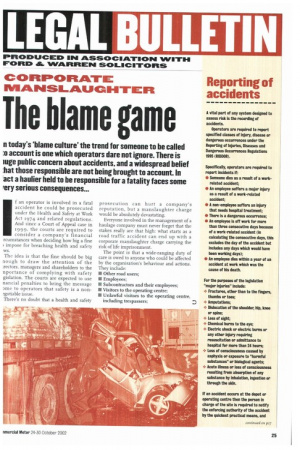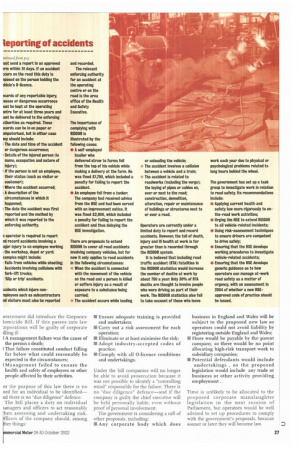Reporting of accidents
Page 25

Page 27

If you've noticed an error in this article please click here to report it so we can fix it.
A vital part of any system designed to assess risk is the recording of accidents.
Operators are required to report specified classes of injury, disease or dangerous occurrences under the Reporting of Injuries, Diseases and Dangerous Occurrences Regulations 1995 (RIDDOR).
Specifically, operators are required to report incidents if: Someone dies as a result of a workrelated accident;
a An employee suffers a major injury as a result of a work-related accident; le A non-employee suffers an injury that needs hospital treatment;
• There is a dangerous occurrence; • An employee is off work for more than three consecutive days because of a work-related accident (in calculating the consecutive days, this excludes the day of the accident but includes any days which would have been working days); • An employee dies within a year of an accident at work which was the cause of his death.
For the purposes of the legislation "major injuries" include: Fractures, other than to the fingers, thumbs or toes;
.4Amputations;
Dislocation of the shoulder, hip, knee
or spine;
4.. Loss of sight; 4. Chemical burns to the eye: -1Electric shock or electric burns or any other Injury requiring resuscitation or admittance to hospital for more than 24 hours; .1. Loss of consciousness caused by
asphyxia or exposure to "harmful substances" or biological agents;
4. Acute illness or loss of consciousness resulting from absorption of any substance by inhalation, ingestion or through the skin.
If an accident occurs at the depot or operating centre then the person in charge of the site is required to notify the enforcing authority of the accident by the quickest practical means, and
flat send a report in an approved irm within 10 days. If an accident ;curs on the road this duty is nposed on the person holding the )hicle's 0-licence.
Nerds of any reportable injury, Issas° or dangerous occurrence :ust be kept at the operating fintre for at least three years and lust be delivered to the enforcing uthorities as required. These cords can be in on paper or umputerised, but In either case ley should include:
The date and time of the accident or dangerous occurrence; Details of the injured person (ie name, occupation and nature of Injury); ■ If the person is not an employee, their status (such as visitor or customer); Where the accident occurred; A description of the circumstances in which it happened; The date the accident was first reported and the method by which it was reported to the enforcing authority.
n operator is required to report nd record accidents involving a iajor injury to an employee working the workshop, depot or yard. (amples might include; Falls from vehicles while sheeting; Accidents involving collisions with fork-lift trucks; 'Slip or trip accidents.
ocidents which injure nonnployees such as subcontractors rid visitors must also be reported and recorded, The relevant enforcing authority for an accident at the operating centre or on the road Is the area office of the Health and Safety Executive.
The importance of complying with RIDDOR is illustrated by the following cases: • A self-employed haulier who delivered straw to farms fell from the top of his vehicle while making a delivery at the farm. He was fined 11,700, which Included a penalty for failing to report the accident.
• An employee fell from a tanker. The company had received advice from the HSE and had been served with an improvement notice. It was fined 12,000, which Included a penalty for failing to report the accident and thus delaying the HS[ investigation.
There are proposals to extend RIDDOR to cover all road accidents Involving company vehicles, but for now it only applies to road accidents in the following circumstances: When the accident is connected with the movement of the vehicle on the road and a person Is killed or suffers injury as a result of exposure to a substance being carried; The accident occurs while loading or unloading the vehicle; The accident involves a collision between a vehicle and a train: The accident is related to roadworks (including the verge); the laying of pipes or cables on, over or next to the road; construction, demolition, alteration, repair or maintenance of buildings or structures next to or over a road.
Operators are currently under a limited duty to report and record accidents. However, the toll of death, injury and ill health at work is far greater than Is recorded through the RIDDOR system.
It is believed that Including road traffic accident (RTA) fatalities in the RIDDOR statistics would increase the number of deaths at work by about 700 a year. Only 30% of RTA deaths are thought to involve people who were driving as part of their work. The RIDDOR statistics also fall to take account of those who leave
work each year due to physical or psychological problems related to long hours behind the wheel.
The government has set up a task group to investigate work in relation to road safety. Its recommendations include: Applying current health and safety law more rigorously to onthe-road work activities; • Urging the HSE to extend RIDDOR to all vehicle-related incidents; • Using risk-assessment techniques to ensure drivers are competent to drive safely; Ensuring that the HSE develops working procedures to investigate vehicle-related accidents;
4. Ensuring that the HSE develops generic guidance as to how operators can manage at-work road safety as a matter of urgency, with an assessment in 2004 of whether a new HSEapproved code of practice should be issued.
























































































































































